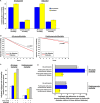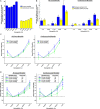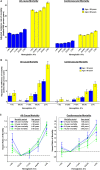Diabetes Mellitus-Related All-Cause and Cardiovascular Mortality in a National Cohort of Adults
- PMID: 30776949
- PMCID: PMC6405678
- DOI: 10.1161/JAHA.118.011295
Diabetes Mellitus-Related All-Cause and Cardiovascular Mortality in a National Cohort of Adults
Abstract
Background Diabetes mellitus is a risk factor for cardiovascular disease ( CVD ) and has been associated with 2- to 4-fold higher mortality. Diabetes mellitus-related mortality has not been reassessed in individuals receiving routine care in the United States in the contemporary era of CVD risk reduction. Methods and Results We retrospectively studied 963 648 adults receiving care in the US Veterans Affairs Healthcare System from 2002 to 2014; mean follow-up was 8 years. We estimated associations of diabetes mellitus status and hemoglobin A1c (HbA1c) with all-cause and CVD mortality using covariate-adjusted incidence rates and multivariable Cox proportional hazards regression. Of participants, 34% had diabetes mellitus. Compared with nondiabetic individuals, patients with diabetes mellitus had 7.0 (95% CI , 6.7-7.4) and 3.5 (95% CI, 3.3-3.7) deaths/1000-person-years higher all-cause and CVD mortality, respectively. The age-, sex-, race-, and ethnicity-adjusted hazard ratio for diabetes mellitus-related mortality was 1.29 (95% CI, 1.28-1.31), and declined with adjustment for CVD risk factors (hazard ratio, 1.18 [95% CI, 1.16-1.19]) and glycemia (hazard ratio, 1.03 [95% CI, 1.02-1.05]). Among individuals with diabetes mellitus, CVD mortality increased as HbA1c exceeded 7% (hazard ratios, 1.11 [95% CI, 1.08-1.14], 1.25 [95% CI, 1.22-1.29], and 1.52 [95% CI, 1.48-1.56] for HbA1c 7%-7.9%, 8%-8.9%, and ≥9%, respectively, relative to HbA1c 6%-6.9%). HbA1c 6% to 6.9% was associated with the lowest mortality risk irrespective of CVD history or age. Conclusions Diabetes mellitus remains significantly associated with all-cause and CVD mortality, although diabetes mellitus-related excess mortality is lower in the contemporary era than previously. We observed a gradient of mortality risk with increasing HbA1c >6% to 6.9%, suggesting HbA1c remains an informative predictor of outcomes even if causality cannot be inferred.
Keywords: cardiovascular disease; diabetes mellitus; mortality.
Figures



Comment in
-
Improving Outcomes in Patients With Diabetes Mellitus.J Am Heart Assoc. 2019 Feb 19;8(4):e011971. doi: 10.1161/JAHA.119.011971. J Am Heart Assoc. 2019. PMID: 30776984 Free PMC article.
References
-
- Danaei G, Finucane MM, Lu Y, Singh GM, Cowan MJ, Paciorek CJ, Lin JK, Farzadfar F, Khang YH, Stevens GA, Rao M, Ali MK, Riley LM, Robinson CA, Ezzati M; Global Burden of Metabolic Risk Factors of Chronic Diseases Collaborating Group . National, regional, and global trends in fasting plasma glucose and diabetes prevalence since 1980: systematic analysis of health examination surveys and epidemiological studies with 370 country‐years and 2.7 million participants. Lancet. 2011;378:31–40. - PubMed
-
- Centers for Disease Control and Prevention . National Diabetes Statistics Report: Estimates of Diabetes and Its Burden in the United States. Atlanta, GA: Centers for Disease Control and Prevention, US Department of Health and Human Services; 2017.
-
- Emerging Risk Factors Consortium , Seshasai SR, Kaptoge S, Thompson A, Di Angelantonio E, Gao P, Sarwar N, Whincup PH, Mukamal KJ, Gillum RF, Holme I, Njolstad I, Fletcher A, Nilsson P, Lewington S, Collins R, Gudnason V, Thompson SG, Sattar N, Selvin E, Hu FB, Danesh J. Diabetes mellitus, fasting glucose, and risk of cause‐specific death. N Engl J Med. 2011;364:829–841. - PMC - PubMed
Publication types
MeSH terms
Substances
Grants and funding
LinkOut - more resources
Full Text Sources
Medical
Molecular Biology Databases

